
P. David Ebersole & Todd Hughes have all the hallmarks of a married couple. Dressed in matching black and white checkered shirts, the pair giggle and have a penchant for somehow completing each other’s sentences without interrupting one another.
They also make movies together. Hughes long served as Ebersole’s producer, as the latter directed episodes of Wicked, Wicked Games and Desire before moving into documentary filmmaking. Their rock biopic Hit So Hard told the life story of Patty Schemel, the lesbian drummer of the band Hole. Dear Mom, Love Cher focused on the mother-daughter relationship between rock icon Cher and her mother, Georgia Holt. Mansfield 66/67 recounted the rise and untimely death of screen icon Jayne Mansfield.
Now the pair return with House of Cardin, the first-ever in-depth look at legendary fashion designer Pierre Cardin. Utilizing hours of archive footage, as well as extensive interviews with 97-year-old Cardin, his friends, associates, and celebrity models including Naomi Campbell, Sharon Stone and Alice Cooper (yes, Alice Cooper), the film pulls back the veil on a queer style icon, business genius and cultural innovator.
We caught up with Ebersole and Hughes on the eve of Frameline44, film festival sponsored by Frameline, the San Francisco-based queer media arts foundation. House of Cardin played at the virtual festival June 25-28, and will have a streaming and theatrical release later this September.
How about we take this to the next level?
Our newsletter is like a refreshing cocktail (or mocktail) of LGBTQ+ entertainment and pop culture, served up with a side of eye-candy.
So why Pierre Cardin?
TH: Well, it’s a strange story. We moved to Palm Springs six years ago. We grew up in the 70s, so we had the cologne.
The famous penis bottle?
PDE: Yeah.
TH: In the film, he says “It’s a little sexy.” And the name was of the perfume was “The Male Sex.”
PDE: Right.

TH: He doesn’t mince words. But anyway, we knew his name. I remember arguing with my dad to buy Pierre Cardin skis, which were more expensive, and he was like you’re paying for the name! When we moved to Palm Springs we discovered his furniture, because everyone here has that mid-century theme. We wanted to be more 70s, more disco.
PDE: Our house was built in 1969, so we approached it from this Halston-Gucci-Fiorucci design aesthetic. We wanted to do something a bit more…
TH: Barbarella.
PDE: Yeah, Barbarella.
I love it.
PDE: That’s when we stumbled on Cardin, because he’s a space-age designer. So we started with a coffee table. We call that the coffee table that started it all. We stumbled on it, and we thought it was perfect. I found a picture online. But everyone we asked about it said “It’s the Holy Grail. You’ll never find it.” So I posted it online saying it was my dream coffee table. A friend of ours was having writer’s block…
TH: In Oklahoma.
PDE: So he stayed up all night Googling. And he found it at a shop in the UK. It was more expensive than a piece of furniture we’d ever bought before, but we took it as a sign.
TH: It was perfect.
PDE: We had it shipped. We had to go down to LAX to get it out of furniture jail. We got it home, and it was perfect.
TH: Then this woman we met here gave us a Pierre Cardin credenza that she just wanted to get rid of.
That’s lucky.
TH: It’s amazing. So then we Googled, because we needed everything.
PDE: We got obsessed. We’re documentary filmmakers, and it’s what we do. But it hadn’t occurred to us to make a film about him.
TH: Not at all.
PDE: Then we bought his 1972 Javelin car. It’s in the movie as well.

You have the Javelin? Wow.
TH: This was 2015. 2016 we got a fellowship to go work in Leeds. So we went and made our Jayne Mansfield documentary there. Our visa was expiring, so they said “Pop over to France and get a tourist visa to last six months.” So we popped over to France. And we were obsessed, so we decided to go to Paris to the flea market, because they’d have it all. Then we were coming home, and we went to a beer bust at the bear bar, and we stumbled across the Cardin Museum. It was closed, but there was a shop open called Evolution, which had all this avant-garde stuff.
PDE: It’s a men’s couture shop.
TH: The guy working there was beautiful, so we were flirting with him. He said “Monsieur Cardin would love to meet you.” And we went, what?
PDE: We didn’t realize he was still alive.
TH: We’d never Googled him personally. We had no interest in his life, or even his clothes. Just his furniture. Anyway, Valentin was telling us about Pierre Cardin, and he said “I’ll tell you how to run into him. Show up at his flagship store on Tuesday morning. Tell him you’re fans.” So later, we were in Paris, and we walked in on Tuesday. Then Rodrigo [Cardin’s nephew] comes down the stairs and says “This is a good year to do a documentary on my uncle.” He brought it up. He sat down for a half-hour. At that point, we were saying is he telling us we can make the documentary?
A reasonable question, all things considered.
PDE: Then we went to lunch. To wrap up our Pierre Cardin day, we went to his little restaurant for lunch. He has the restaurant MMaxim’s, and Minim’s: it’s a salon de thé. So we go sit down, and the shop lady we had met walks in. They all eat lunch at Pierre’s restaurant. Then the maitre d’ brings the phone over to our table. We’d been spotted.
Related: Haaz Sleiman, Jackie Beat and more: our seven must-see titles from a virtual Frameline44
Oh my goodness.
PDE: It was Rodrigo. He said, “I talked to my uncle about you. He’d like to meet.” So 2 pm that day, we sat down with Cardin. We showed him everything we have on our phones, and when I got to the car, he stopped. He looked at the phone. He looked at me. He looked at Todd. And then he said, “When do you want to start?”
That’s a movie unto itself. What serendipity.
TH: We said we wanted to do it in 3D. He said “I love the idea.”
PDE: But that never happened.
[Laughter]
TH: We walked down the Champs-Elysees, and we were dancing.
Please include that footage on the Blu-Ray.
[Laughter]
TH: Then we looked at his Wiki. He opened the House of Dior. He did the costumes for the [Cocteau] Beauty and the Beast. We hit the jackpot.
PDE: His story is so huge. It’s a 70-year career. All that amazing archival footage we found…he’s been in the public eye since he was 22 years old. So the footage of him at Dior is from 1945. It’s the first footage we found of him. And he’d never agreed to do a documentary before. He’s never allowed a biography to be written about him. But, every so often, there’s a special about him on French TV. So over the decades, there was all this incredible footage of him telling stories, telling who he is, talking about his philosophies or his fashion or furniture. It was a treasure trove.

And his career is so varied. That bowled me over watching it. He’s done so much for international relations. He did costumes for Cocteau, which alone makes him someone to know.
PDE: Legendary, yeah.
TH: We want to nominate him for the Nobel Peace Prize. Seriously. This man saw the future: globalism, but also to make cultures accept, understand and love each other. Not to make money. What he did inadvertently was taught cultures to use their own materials and be proud of their cultures and then sell it. Now, Pierre Cardin China is huge.
It’s remarkable. The approach you take to him in the film is as if to say yes, this man is an artist. But he’s more than that: he’s an innovator. And he’s a brilliant businessman. And he’s comfortable around celebrities and world leaders and his own employees.
PDE: It’s all tiers. I love the clip we have where he says he’s comfortable around the maids and concierge and the Dutchess of Winsor.
I’m not sure he should have been comfortable around the Dutchess of Windsor. Wallis Simpson was a Nazi.
[Laughter]
TH: When we met Jean-PaulGaultier and Philippe Starck, it was the same thing. You meet the man, and he’s like you. Everyone we met in the Cardin world it was the same thing. He’d see someone doing window dressing and say “You have potential.”
When it comes to that sense, where does that instinct, that courage come from?
PDE: It’s interesting. He was one of the only couturiers to come from no money. When you talk about Dior, St. Laurent, they were all boys from rich families. Cardin came from the poor.
TH: Immigrant parents.
PDE: They had to escape Mussolini and ended up in the middle of France with nothing except being discriminated against. So I think he was someone that always had a more inclusive vision. He wasn’t someone who would have thought that fashion is for the whole world, not just wealthy white women in Paris. Why isn’t expression for everyone?

So his courage comes out of being who he is.
TH: He arrived in Paris at a critical moment after the war and fell in with the cream of the crop. He hit the bullseye. So he was hanging out with all these exciting intellectuals, and of course, they were all gay and lusted after Pierre. He didn’t want to go that route. He was Catholic, and I don’t think he had come out yet.
PDE: They also had to reinvent everything. Coming to Paris in 1945, Coco Chanel had been thrown out and all the fashion houses had closed down.
TH: All of Europe had to be redesigned.
You hit on possibly his most important innovation there: he included men in high fashion cotoure, at a time when people didn’t design for men. And he used people of color as models. That was unheard of. It astonishes me that nobody thought to do that.
PDE: If you look at those earlier days of what the fashion world looked like, they were modeling it after themselves: beautiful white girls in expensive clothing. Cardin, just intuitively, had a broader vision. So he went to Japan and discovered Hiroko. He brought her back from Japan and put her on the runway. She became a sensation. It’s one thing we love about him: the idea of being different will bring good things.
TH: Then everyone did it. Dior did it the next year.
So let me ask a bit about your careers. This is your second film as co-directors.
PDE: When we started out we thought we should wear different hats.

TH: We come from narrative filmmaking. We thought we’d be like Merchant-Ivory, where one is producer and one is director. Then we saw the Cohen Brothers were like produced and directed by…
PDE: It really has been from the beginning that the jobs are so merged. We just thought we should name one person as one job. But by the time we got to Mansfield 66/67, we were both doing it all. So we decided to co-direct and co-produce.
TH: We needed bilingual editors for Cardin.
PDE: The whole movie had to be translated to edit. As soon as you separated subtitles from the footage you had no idea what anyone was saying to you anymore. So the subtitles had to override any B-roll, so that if you cut away the subtitles would stay and you could understand what someone was saying.
Well, let’s talk about that challenge a bit. On a film like this, there are so many unusual moving pieces, and you have to coordinate all of them. And you live together on top of that. How do you find a dynamic to have personal time, work time, and compartmentalize all these different parts of your lives together?
PDE: First, we’re best friends. We get along and enjoy being together, so we don’t really have that issue that a lot of couples have where they want to spend time apart. In a work environment, we have different skills. Todd is very quick and has no writer’s block whatsoever. I’m slow, plodding and careful and like a lot of structure. So he’ll put something together and I’ll go I need that. So we’ve discovered that we just let our strengths play.
That’s wonderful.
PDE: I often say that when I want him to go for it, I don’t tell him what my ideas are. He’s a wild genius and will come up with things I never thought of. So we’ve learned to ebb and flow.
How do you challenge each other creatively?
PDE: Our styles challenge each other. We’re so different.
TH: When we met, he was very up-tight and very serious. I was super cookey. We realized early on that our combo—he’s very Old Hollywood, classical, and I’m very underground DIY—was very commercial. We were romantic comedy writers for a while with big agents in big rooms. It’s so much easier to do something with somebody. In Hollywood, people are so mean. To have a buddy is so great.
PDE: We listen to each other well. It’s true that if I show something to Todd and he has that look on his face, I know I have more work to do. He has very little ego about the things he’s put together, so when he hands them over I move them all around. It’s very fluid.
TH: We’re a good team.
PDE: We’ve been together since we were 27 years old.
TH: Almost 30 years.
PDE: When I was young, I was just waiting for life to happen. At a certain point, I came up with the idea that life is happening now. Whether you get the success or it all comes together in the moment, if you allow yourself the process and the fun to be part of life, the rest falls into place. The ambition has to stay, but you don’t need to be driven by it at all times.

Looking at your filmographies, and they are very eclectic. There’s not a single element that stands out to me as a unifying trope or subject. Patty Schemel, Jayne Mansfield, Cher, Cardin—there’s not a unifying factor. What attracts you to a subject?
PDE: I call what we do “entertainment with heart.” If you’re looking at Cher’s mother or Patty Schemel, they’re very different people. They’re also people who had struggles and went through what they went through to come out the other side.
TH: A lot of it comes to us. Patty was our neighbor. Cher saw Hit So Hard. Jayne Mansfield was a script we wrote a long time ago that got us fired. Then Cardin was divine intervention.
PDE: The new project we’re working on now is about Trini Lopez, the first Latino rock star. And we met him at a party here in Palm Springs.
That’s amazing.
The past few years we’ve seen more documentaries about fashion designers: McQueen, Halston. Now we’re getting House of Cardin. What’s going on in this cultural moment that we’re getting so much of this material all of the sudden?
TH: I think that fashion, thanks to reality TV, is taken seriously now. Everyone knows something about it. Everyone can relate to it. With social media, we’re always taking pictures of what we’re wearing. So I think it’s just a viable thing.
PDE: Also, when you think about queer artists, we’re at a place where that can be discussed. There was a time where maybe if you did a Halston or Cardin documentary you would have to mostly not talk about it. We appreciate our heroes and we want to stand on their shoulders and recognize that they got us where we are.
TH: Fashion is a ghetto for women and gay men.
I love that.
House of Cardin plays at the virtual Frameline44 June 25-28, and will have a streaming and theatrical release later this September.


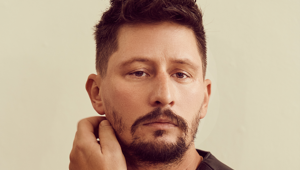

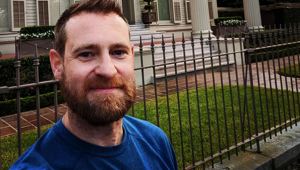


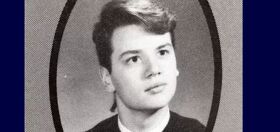

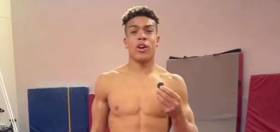


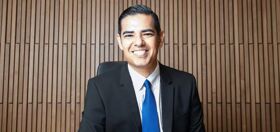

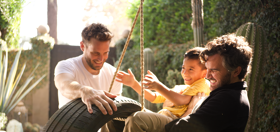


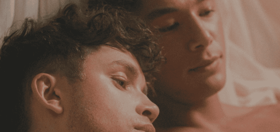


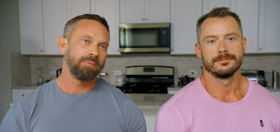
nm4047
didn’t know the label still existed? Clearly, Pierre needed to make a sex tape so the current younger buyers know the name.